Does a grand piano’s case really matter? 3 reasons why it’s important
March 22, 2022 •Stephen Reed
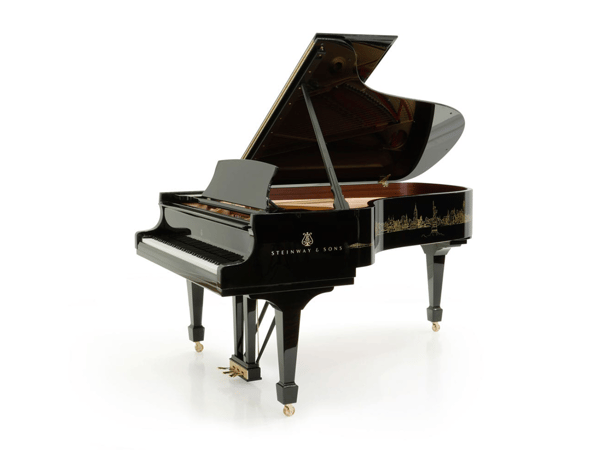
A piano’s wooden cabinet, or case, is one of the most important parts of a grand piano. The case, which includes the rim in a grand piano, is key in protecting the other 12,000 parts of the piano, and it is responsible for critical parts of the piano’s sound, securing its musical quality.
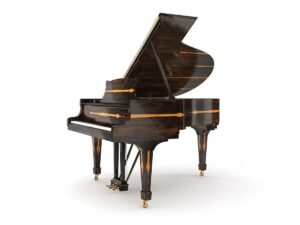
Additionally, taking good care of the piano’s case is essential to maintain strong resale value–both for the protection of the interior of the grand piano as well as its external appearance. After all, the case is what most people visualize when they imagine a grand piano–a large, impressive, wooden structure.
It’s probably what you see in your mind’s eye, too, when the words “grand piano” comes to mind. What could be worse than buying what looks like an attractive grand piano, only to discover later that the case was made with shoddy materials?
M. Steinert & Sons has been helping our customers avoid such pitfalls for over 160 years. We understand how pianos are made and which parts deserve your particular attention.
By the end of this article, you will understand better the three reasons that a grand piano’s case is important: cabinet construction, the rim and its impact on the piano’s musical quality, and how the case allows you to express your personal style. You’ll also learn of some different styles of modern grand piano cases.
Above: This Central American Ziricote veneer on this grand piano case is part of Steinway's Crown Jewel Collection.
1. Cabinet construction: A key element in piano design from the beginning
We tend to forget that some of the world’s great, early piano makers–Henry Steinway, Morris Steinert, and Ignaz Bosendorfer among them–had cabinet making in their backgrounds. They are known today for the beautiful pianos they created.
However, one can definitely say that the piano’s cabinet, or case, was there from the beginning of some of the great grand piano designs we take for granted today.
Approximately 85% of every acoustic piano is wood. The style of cabinetry and wood finish is an important consideration for many piano buyers.
Three types of cabinet construction
Solid core construction: Solid lumber core with two outer layers of veneer on each side. This is the least economical approach to piano building. There are significant variations between manufacturers between types of wood selected and their strength, durability, and grain characteristics.
Plywood: approx. 1⁄2 to 3⁄4 inch plywood panels with face veneers on each side.
Fiberboard: panels made of compressed wood fiber, with face veneers applied to each side. (Most economical approach–often heavier due to presence of glue used to fabricate these materials)
Historically, piano cabinets have used solid core construction. However, plywood and fiberboard are now more prevalent in manufactured pianos. Legs, moulding, and various trim pieces are usually solid wood. On good quality pianos, they are of the same wood species as the rest of the piano’s cabinet.
Each part of a piano’s case has a specific function. A higher-quality build will result in less failure of case components and a longer lifespan overall.
2. Steinway adapts the first modern rim case
Because of Henry Steinway’s commitment to making the best possible piano, Steinway’s handcrafted process has always used solid core construction.
Other piano makers have fine case designs. However, no piano maker has done more to develop an effective rim than Steinway. By 1880, Steinway started to produce their Model A, a smaller grand piano that nevertheless had significant ramifications for their larger grand piano models later.

Steinway’s Model A featured a laminated maple cabinet, resulting in their first modern rim case. This case was created by the use of long, thin planks of maple that were bent around a form and pressed together with glue.
The result was a patented, single-piece, continuous bent-rim that made a stronger and more stable case for the Model A. Steinway had hit upon an approach to their smaller grand pianos’ rims that worked for larger models like the Model D, as well.
The two rims–inner and outer–are essentially the foundation of the piano, along with the back-posts that are attached to the inner rim. Placed on top and attached to the top of the inner rim is the soundboard, which vibrates freely within the perimeter of the outer rim.
The vibrations of the strings after being struck by the hammers are transferred through the maple bridges into the spruce of the soundboard and then instantaneously conducted toward the rims.
Steinway has proven that the rim's job is to absorb as little of that energy as the particular design of a given piano permits, reflecting the acoustic vibrations back into the soundboard and then releasing them outward as sound waves to the ear.
The species and density of the rim wood will determine the degree of efficiency of reflection of sound vibrations toward the ear. Many manufacturers use relatively soft inexpensive hardwoods for rim construction, such as Philippine mahogany (lauan). Steinway uses only more costly North American hard rock maple, known for its unexcelled density, durability, flexibility, and reflective efficiency as well as tonality.
Steinway is the only manufacturer that bends the inner and outer rims together at the same time into one homogeneous unit, thereby eliminating the possibility of rim separation between the inner and outer rims as the piano ages. A separated rim will compromise the tuning stability of the piano as well as have a detrimental effect on tone.
Musical quality is tied to the case’s rim
When it comes to the matter of a grand piano’s musical quality, evaluating the role of the case gets a little complicated. How one actually defines the “case” becomes all-important.
On one hand, many in the piano industry consider the rim, so integral to producing the piano’s sound, as a separate part altogether. What’s left are the other exterior parts of the case–like the lyre, the legs, the music desk, or the fallboard–which do not significantly affect the musical quality of the piano.
On the other hand, others in the piano industry believe the rim should be considered part of the “case,” as the outer rim of the grand is part of the visible cabinetry.
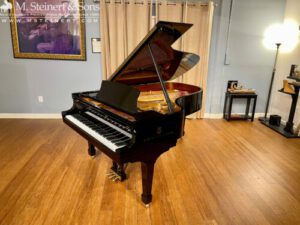
“The outer rim not only defines the primary curved furniture of a grand piano but is integral to its sound,” says Phil Schoonmaker, a veteran piano consultant at M. Steinert & Sons. “So the case, in my view, includes the outer, visible rim which provides architectural design and beauty as well as structural construction essential to tone production.”
According to this view, the case, with rim included, becomes an essential part of the musical quality of a grand piano.
Steinway’s patented one-piece continuous bent rim generates its strength by bending single laminations of premium, straight-grained rock maple in an unbroken curve to form the rim of the piano.
The process of bending our rims completely by hand has taken place in Steinway’s factories for over 140 years, and recent developments in that process have produced a vastly improved piano rim.
Today’s Steinway rim has improved stability, durability, and strength, which together create the distinctive Steinway sound. Never before has Steinway’s rim emboldened the company’s patented Diaphragmatic Soundboard to vibrate so freely and generate a golden tone.
Thus, this patented rim not only helps to strengthen the case but contributes mightily to Steinway’s signature sound.
3. Your piano case is an expression of your personal style
The outer veneer of the piano’s case does not affect musical properties. A designer Steinway Model B has no more or less musical quality than a standard ebony Model B.
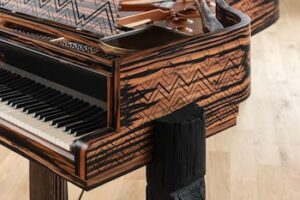
However, the outer veneer of a grand piano’s case can be an expression of the owner’s individuality or decorative style. While the classic ebony Steinway grands are the ones that spring to mind automatically from their ubiquitous presence on concert hall stages around the globe, Steinway has always made available a range of case styles for its customers.
Perhaps best known is the Crown Jewel Collection, with fine veneers like high-quality mahogany, walnut, and East Indian Rosewood, among others.
Steinway also produces limited edition grand pianos, partnering with famous performers like Lang Lang and Lenny Kravitz.
Wrapping a piano’s case in the best color for one’s interior design is another option available at piano stores like M. Steinert & Sons.
As with standard ebony grands, the care and maintenance of more individualized, limited edition grands make a huge difference in any future re-sale.
Why a grand piano case matters
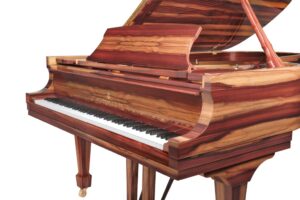 For musical quality, resale value, and aesthetics, the piano’s case matters a great deal. It is the first part of the piano that the owner or audience sees. Plus, it is what protects the other 12,000 parts within the piano.
For musical quality, resale value, and aesthetics, the piano’s case matters a great deal. It is the first part of the piano that the owner or audience sees. Plus, it is what protects the other 12,000 parts within the piano.
Combined with the unique Steinway bent-rim, the case plays a major role in creating the Steinway sound.
The best way to appreciate these contributions of the case to a Steinway grand is to come into our showroom in Newton to allow your senses to take in several different Steinway grands.
On the right: Padauk wood is found in Central America and West Africa. This case's veneer is another from Steinway's Crown Jewel Collection.
In the meantime, learn more about the way Steinway cases are made by reading this article:
Featured Articles
Categories
- Beginner Pianos (17)
- Boston Pianos (12)
- Comparisons (26)
- Designer and Specialty Pianos (8)
- Essex Pianos (10)
- Events (11)
- Featured (22)
- Institutional (3)
- Joy of Piano (14)
- Learning About Pianos (62)
- News (34)
- Pricing and Cost (19)
- Resource Center (117)
- Roland Pianos (6)
- Spirio (14)
- Steinway Pianos (67)
- Student (14)
- Teacher (12)
- Used Pianos (20)
- Videos (17)

